Campus Activities Board Events
Black Heritage Month Exhibition
As part of our ongoing commitment to reflect the USF community by making diversity and inclusion priorities in all that we do, the Centre Gallery is excited to introduce our new partnership with the Office of Multicultural Affairs that celebrates and brings awareness to artists and art focused around commemorative observances such as Black Heritage Month, Pride Month, and Women’s History Month. In working side-by-side with the Office of Multicultural Affairs, the Centre Gallery strives to make this initiative extend beyond a single month or exhibition and allow for USF students to feel confident in sharing and displaying their art any time of the year.
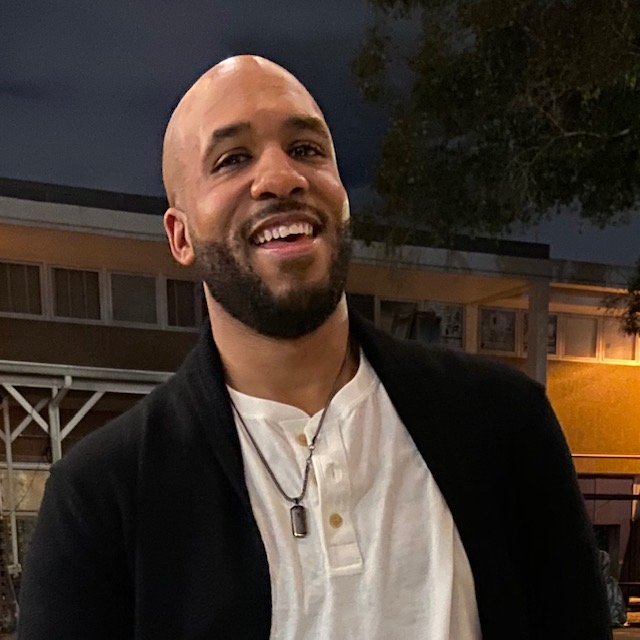

Meet your artist
Marlon Tobias (he/him) is a visual artist influenced by the under-told narratives of the communities around him. As New York native born from a mother of southern roots and a father of Jamaican descent, he became keenly entranced by the multifaceted spirits of the African diaspora and how it informs the very fabric of America society. Using the history of drawing and painting as an anchor, he weaves through various mediums as he chronicles the rich stories framed within the context of his subject’s daily lives. Marlon received his undergraduate degree from the Florida Agricultural and Mechanical University and am currently pursuing his MFA at the University of South Florida.
Artist statement
Black History Month was the product of the late and prominent African American scholar and educator, Dr. Carter G. Woodson. Steadfast in his deep love for his people, and an unwavering conviction and concern that Black folks simply were not learning enough about their enormous contributions to not simply the United States, but to a global community. Since its inception, Black History Month has served to honor and emphasize notable people of African descent across the diaspora and throughout history that have left an indelible impression within their respective fields and humanity at large. The irony is not lost that within a time dedicated to bringing greater awareness to the untold stories of Black folks, there remains many a hero whose stories and contributions are left under-studied and unexplored. A testament that a month alone could never truly be enough to fully explore the vastness of Black contribution to the human experience. And in the same vein that Dr. Woodson’s original Black History Week evolved into a Black History Month, we move forward well aware that Black History is a 365-day experience.
In this series of paintings, Marlon honors 28 African Americans whose lives and contributions have remained largely unexplored. Spanning across various facets of life and history, these unsung figures have made compelling impacts across an array of disciplines and professions. However, their accomplishments exist without their deserved laud. This series aims to pull their stories to the forefront as well as demonstrate diasporic diversity through their unique intersecting identities. The color palette in most of the work is monochromatic. The subjects are grounded in their respective color schemes which were carefully selected to represent a significant aspect of their lives and achievements.
Artist Questions
Please share why you decided to submit your work for Black Heritage Month?
This series of work is dedicated toward honoring the key impacts made by those unsung
figures in American history; names often unsaid, faces not often seen. I wanted to
use Black Heritage Month as a platform to shine a light on their achievements and
place their contributions in the same reverence as those key figures that are often
recognized.
How has Black/African American heritage/culture influenced your life?
As a son of a mother of Black southern roots and a Jamaican father, to be Black and
to be American is a major component of my identity. I have always been in awe the
multifaceted beauty of the Black diaspora and inspired by our unwavering resilience
in spite of our systematic barriers. Black/African American culture is a badge I wear
of honor, and I take that honor into every space I step into.
How can you use your artist platform to inform and educate others of the rich history,
challenges, and successes of the Black and African American communities?
As an artist my goal is to uncover and honor the dynamic history of black people through
equally captivating and thought-provoking works of art that people can engage with
and visually admire. It is my hope that when a viewer walks away from my work with
a new insight that leads to further exploration into the subject.
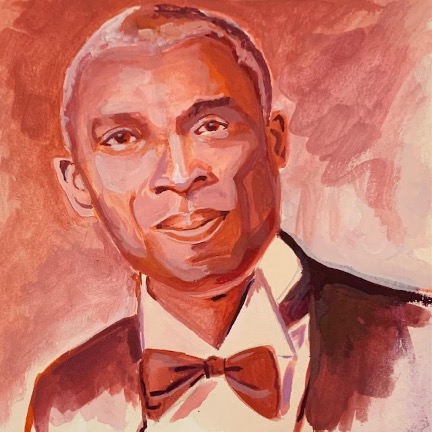

John Morton-Finney
8x8in gouache paintings predominately monochromatic in hue
LET’S TALK ABOUT John Morton-Finney!
Genius is not the word for who this man was. Born to a formerly enslaved father and a free mother, Morton-Finney spent the first part of his grandfather on his farm in Missouri.
In 1911, at 22 years of age, he joined the Army and served until 1914, interrupting his enrollment at Lincoln University in Jefferson City, Missouri. While in the Army, he was a member of the 24th Infantry Regiment, a Black-only regiment. Due to racism and discrimination, even though he earned the rank of corporal and sergeant, he was denied officer status. In 1918, Morton-Finney served in France in World War I as an infantryman in the American Expeditionary Force. He was cited for directing the rationing tickets program for African Americans in Indianapolis during World War II.
John Morton-Finney had a voracious appetite for education. He earned a total of five law degrees. He also earned master's degrees from Indiana University in education and French. Morton-Finney also held undergraduate degrees from Lincoln Institute, Iowa State University, and Butler University. Late in life, he was awarded a Doctor of Letters (Litt.D.) from Lincoln University and received an honorary Doctor of Humane Letters degree (L.H.D.) from Butler University. Morton-Finney was fluent in French, Latin, Greek, and Spanish and conversant in German and Portuguese.
He was admitted as a member of the Bar of the Indiana Supreme Court in 1935 and as a member of the Bar of the U.S. District Court in 1941. At the age of 83, Morton-Finney was admitted to practice before the U.S. Supreme Court in 1972. He was inducted into the National Bar Association Hall of Fame in 1991. When Morton-Finney retired from practicing law at the age of 107, he was believed to have been the oldest practicing attorney in the United States.
Morton-Finney died on January 28, 1998, at the age of 108. At the time of his death, Morton-Finney was Indiana's oldest veteran.
Hues of red drape over him to acknowledge his service in the 24th Infantry Regiment, better known as the Buffalo Soldiers.
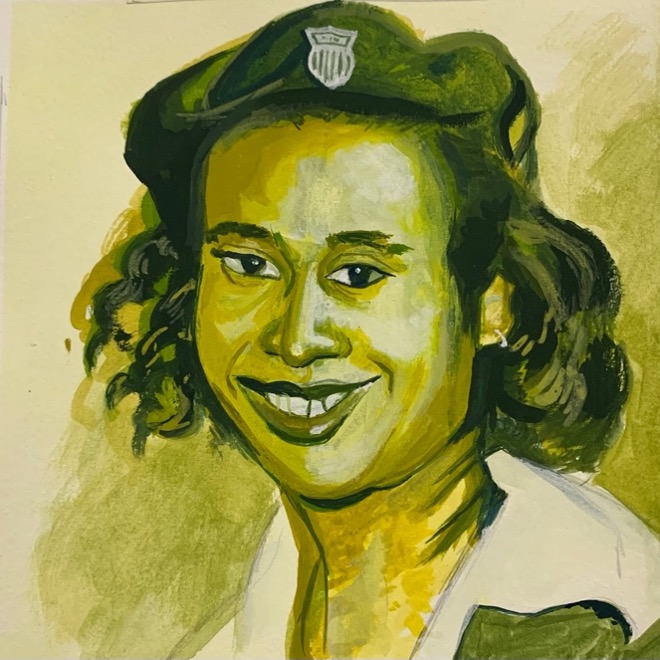

Alice Coachman
8x8in gouache paintings predominately monochromatic in hue
LET’S TALK ABOUT Alice Coachman!
Born with the spirit of a competitor, this woman's unwavering grit would take her to sport's world stage, the 1948 Olympics, and make her a trailblazer for every black female athlete to follow.
Growing up in Jim Crow South, Coachman was unable to access athletic training facilities or participate in organized sports. Her status as a female athlete during a time of widespread opposition to women in sports also added another barrier to her early training. She trained using what was available to her, running shoeless along the dirt roads near her home and using homemade equipment to practice her jumping.
As a youth, Coachman competed in the Amateur Athletic Union's (A.A.U.) Women's National Championships breaking the college and National high jump records while competing barefoot. Her achievements would earn her a scholarship to Tuskegee Preparatory School. She would graduate with a degree in dressmaking from the Tuskegee Institute in 1946 and continue her studies at Albany State College, receiving a B.S. in Home Economics with a minor in science.
While at Tuskegee, Alice Coachman won national championships in the 50-meter dash, the 100-meter dash, and the 400-meter relay team.
Despite being in her prime, Coachman was unable to compete in the 1940 and 1944 Olympic Games as they were canceled because of World War II. Coachman's first opportunity to compete on a global stage was during the 1948 Olympic Games in London.
In the high jump finals of the 1948 Summer Olympics, Coachman leaped 1.68 m (5 ft 6⅛ in) on her first try. Her nearest rival, Great Britain's Dorothy Tyler, matched Coachman's jump, but only on her second try. Coachman was not only the only American woman to win an Olympic gold medal in athletics in 1948 but also the first black woman to win an Olympic gold medal.
In 1979 Coachman was inducted into the Georgia Sports Hall of Fame. During the 1996 Summer Olympic Games in Atlanta, Coachman was honored as one of the 100 greatest Olympians. In the opinion of
sportswriter Eric Williams, though, "Had she competed in those canceled Olympics, we would probably be talking about her as the No. 1 female athlete of all time."
Her golden hues exemplify her contributions to athletics as well as her golden spirit.
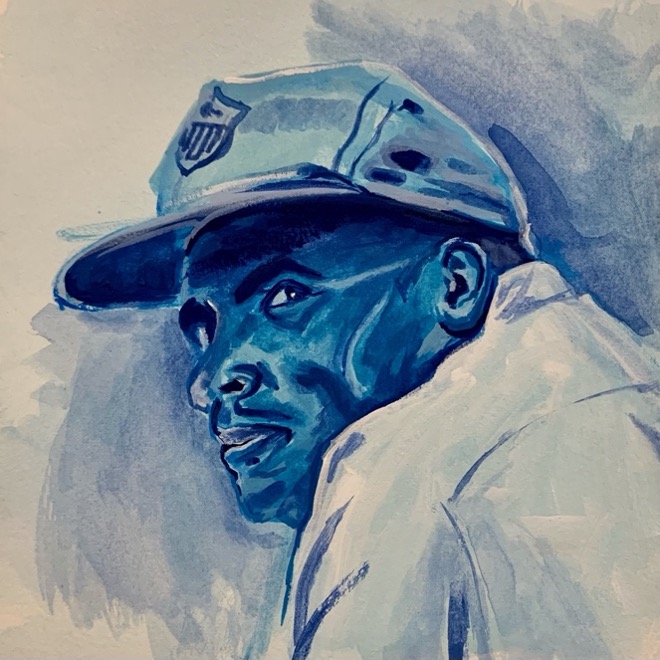

8x8in gouache paintings predominately monochromatic in hue
LET’S TALK ABOUT Ed Temple!
Behind every athlete are the visionary mind and the tenacious backbone of their coach. During a time when limited opportunities were offered for Black female athletes, Ed Temple curated a track and field program that not only provided an outlet for them to compete fairly but built a team of world-class athletes who changed the landscape of women's track forever.
Temple was Head Women's Track and Field Coach at Nashville's Tennessee State University for 44 years. There were a few countries, like Germany, that dominated track and field, particularly at the Olympic Games, up until the mid-1950s. But then Ed Temple and the Tennessee State Tigerbelles made their presence known at the Games in Melbourne, Australia, in 1956 when they won several bronze medals.
They continued that domination at the Olympic Games in Rome in 1960, highlighted by Wilma Rudolph's three gold medals, the first American woman to win that many gold medals in track and field during a single Olympic Games. He served as Head Coach of the U.S. Olympic Women's Track and Field Team twice, in 1960 and 1964, and Assistant Coach in 1980. He was also a member of the International Women's Track & Field Committee and a member of the U.S. Olympic Council.
During his coaching career at Tennessee State University, forty members of the famed Tigerbelle teams represented their countries in Olympic competition. Coach Temple led the
team to 34 national titles, and 8 Tigerbelles have been inducted into the National Track and Field Hall of Fame, including Wilma Rudolph, Edith McGuire, Wyomia Tyus, and Chandra Cheeseborough, the current Women's Coach at T.S.U.
Temple is a member of nine different Halls of Fame, including the United States Olympic Hall of Fame, the National Track and Field Hall of Fame, the Tennessee Sports Hall of Fame, and the Pennsylvania Sports Hall of Fame. On August 28, 2015, a statue to memorialize Temple was unveiled along a greenway near the right-field entrance to First Horizon Park, a Minor League Baseball stadium in Nashville. In 2014, Temple was honored by becoming the first U.S.A. Track & Field Legend Coach.
He is honored in hues of blue and tints of white, the school colors where this athletic excellence was bred, Tennessee State University.
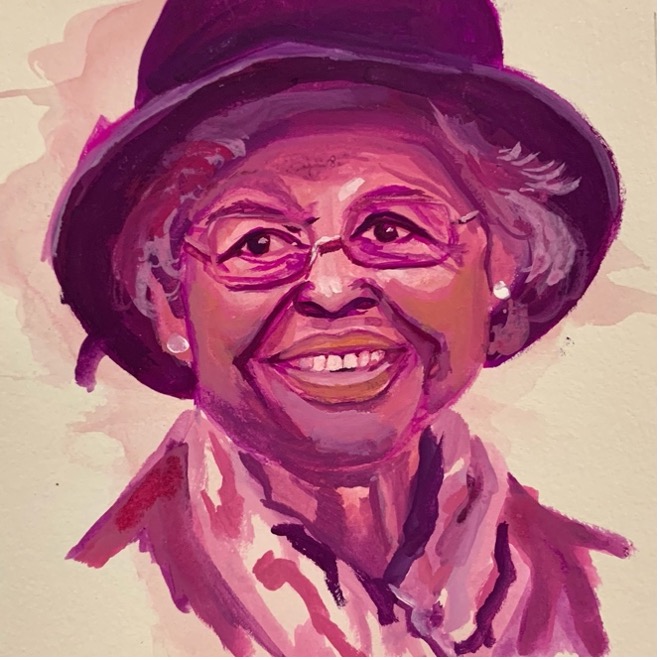

8x8in gouache paintings predominately monochromatic in hue
LET’S TALK ABOUT Dr. Gladys West!
For someone who is directionally challenged, such as myself, her contributions to the world are a saving grace, lol.
Dr. Gladys West is an American mathematician known for her contributions to the mathematical modeling of the shape of the Earth. She was born in a rural county south of Richmond to a farming family in a community of sharecroppers. West realized early that she did not want to work in the tobacco fields or factories like the rest of her family and decided that education would be her way out. She graduated high school valedictorian in her class, earning her a full scholarship to Virginia State College (now formally University). She graduated with a Bachelor of Science in Mathematics in 1952 and a Masters of Mathematics in 1955.
In 1956, West was hired to work at the Naval Proving Ground in Dahlgren, Virginia, where she was the second black woman ever hired and one of only four black employees.
In the early 1960s, she participated in an award-winning astronomical study that proved the regularity of Pluto's motion relative to Neptune. Subsequently, West began to analyze data from satellites, putting together altimeter models of the Earth's shape. She became project manager for the Seasat radar altimetry project, the first satellite that could remotely sense oceans. West consistently put in extra hours, cutting her team's processing time in half.
From the mid-1970s through the 1980s, West programmed an I.B.M. computer to deliver increasingly precise calculations to model the shape of the Earth – an ellipsoid with irregularities, known as the geoid. Generating an extremely accurate model required her to employ complex algorithms to account for variations in gravitational, tidal, and other forces that distort Earth's shape. West's data ultimately became the basis for the Global Positioning System (G.P.S.).
West's vital impact on G.P.S. technology was rediscovered when a member of West's sorority read a short biography Gladys had submitted for an alumni function.
West was inducted into the United States Air Force Hall of Fame in 2018, one of the highest honors bestowed by Air Force Space Command. The AFSPC press release at the time called her one of "the so-called 'Hidden Figures' part of the team who did computing for the U.S. military in the era before electronic systems" – a reference to the 2016 book by Margot Lee Shetterly, which was adapted into the film Hidden Figures.
She is heralded with salmon-pink undertones in honor of her sorority, Alpha Kappa Alpha, the organization that brought her contributions back to the forefront to be recognized and celebrated.
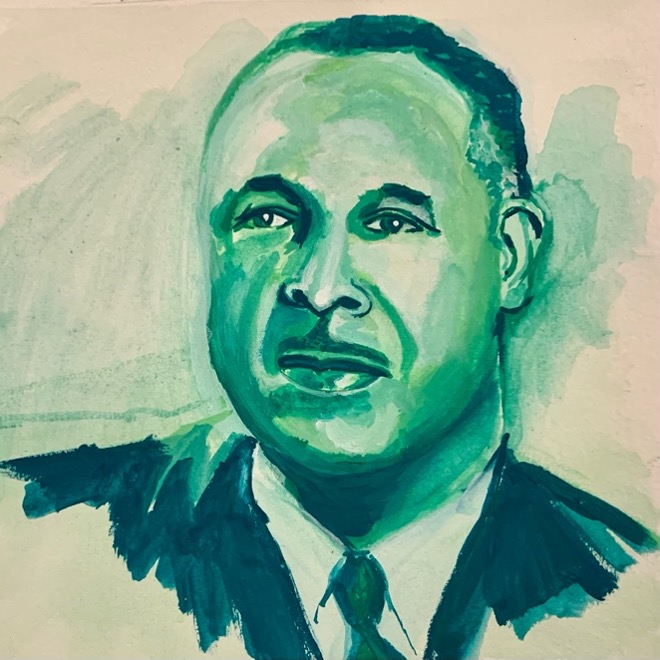

8x8in gouache paintings predominately monochromatic in hue
LET’S TALK ABOUT Percy Julian!
Percy Julian was an American research chemist and a pioneer in the chemical synthesis of medicinal drugs from plants.
The grandson of a slave, Julian grew up in the time of racist Jim Crow culture and legal regime in the southern United States. Among his childhood memories was finding a lynched man hanged from a tree while walking in the woods near his home.
At a time when access to an education beyond the eighth grade was extremely rare for African Americans, Julian's parents steered all of their children toward higher education. Julian attended DePauw University in Greencastle, Indiana. The college accepted few African-American students, and the segregated nature of the town subjected him to social humiliations. He was not allowed to live in a college dormitory and first stayed in an off-campus boarding home, which refused to serve him meals. It took him days before he found an establishment where he could eat. He later found work firing the furnace, waiting tables, and doing other odd jobs in a fraternity house; in return, he was allowed to sleep in the attic and eat at the house. Julian graduated from DePauw in 1920 as a Phi Beta Kappa and valedictorian.
After graduating from DePauw, Julian wanted to obtain his doctorate in chemistry but learned it would be difficult for an African American to do so. While an instructor at Howard University, Julian received a Rockefeller Foundation fellowship to continue his graduate work at the University of Vienna, where he earned his Ph.D.
He was the first to synthesize the natural product physostigmine, plus a pioneer in the industrial large-scale chemical synthesis of the human hormones progesterone and testosterone from plant sterols such as stigmasterol and sitosterol. His work laid the foundation for the steroid drug industry's production of cortisone, other corticosteroids, and birth control pills.
He later started his own company to synthesize steroid intermediates from the wild Mexican yam. His work helped greatly reduce the cost of steroid intermediates to large multinational pharmaceutical companies, helping to significantly expand the use of several important drugs.
Julian received more than 130 chemical patents. He was one of the first African Americans to receive a doctorate in chemistry. He was the first African-American chemist inducted into the National Academy of Sciences and the second African-American scientist inducted (after David Blackwell) from any field.
He is revered in undertones of Vienna green, Vienna, the foreign city that would allow him to earn his Ph. D and continue his career in chemistry.